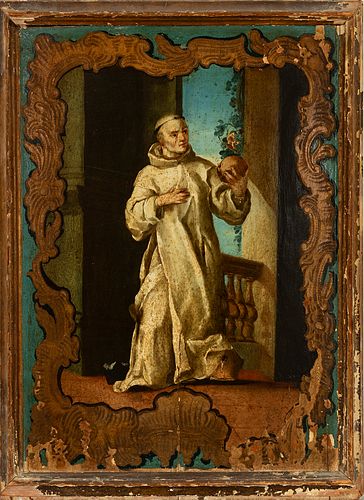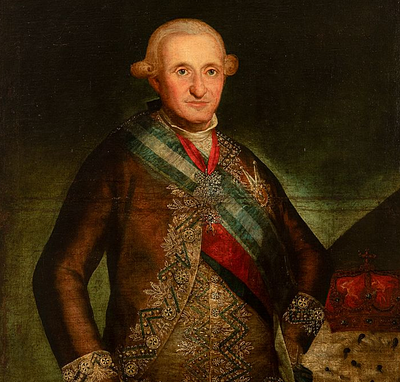Novo-Hispanic school; first half of the 18th century. "Saint Bruno". Oil on panel. Stencilled.
Lot 9
About Seller
Setdart Auction House
Carrer Aragó 346
Barcelona
Spain
Setdart Subastas was born in 2004 and is currently the first online art auction in Spain with solidity, prestige and reliability guaranteed by our more than 60,000 users. Setdart has a young, dynamic and enterprising team ready to successfully manage the purchase and sale of art works through custom...Read more
Estimate:
EUR€800 - EUR€1,000
$824.74 - $1,030.93
Absentee vs Live bid
Two ways to bid:
- Leave a max absentee bid and the platform will bid on your behalf up to your maximum bid during the live auction.
- Bid live during the auction and your bids will be submitted real-time to the auctioneer.
Bid Increments
| Price | Bid Increment |
|---|---|
| EUR€0 | EUR€10 |
| EUR€200 | EUR€25 |
| EUR€500 | EUR€50 |
| EUR€1,000 | EUR€100 |
| EUR€3,000 | EUR€200 |
| EUR€5,000 | EUR€500 |
| EUR€10,000 | EUR€1,000 |
| EUR€20,000 | EUR€2,000 |
| EUR€50,000 | EUR€5,000 |
About Auction
By Setdart Auction House
Sep 22, 2021
Set Reminder
2021-09-22 09:30:00
2021-09-22 09:30:00
America/New_York
Bidsquare
Bidsquare : 22nd September - ARAS JÁUREGUI Private Collection - Old Masters, 19th & 20th Century
https://www.bidsquare.com/auctions/setdart-auction-house/22nd-september---aras-j-uregui-private-collection---old-masters-19th-20th-century-7427
ARAS JÁUREGUI Private Collection - Old Masters, 19th & 20th Century Setdart Auction House sofia@setdart.com
ARAS JÁUREGUI Private Collection - Old Masters, 19th & 20th Century Setdart Auction House sofia@setdart.com
- Lot Description
Novo-Hispanic school; first half of the 18th century. "Saint Bruno". Oil on panel. Stencilled. It presents faults. Measurements: 60 x 44,5 cm. Bruno of Cologne (c. 1030-1101) was a German monk, founder of the contemplative religious order of the Carthusians. During his youth he was a canon in Cologne, and studied secular and theological letters. He later went to Rheims in France to study theology and became a professor in 1057. There he became director of teaching, and among his students was Eudes of Chatillon, the future Pope Urban II. He then opted for the life of a hermit, under the guidance of Robert of Molesmes. Bishop Hugh of Grenoble gave him the mountainous area of the Charterhouse, where he built an oratory surrounded by cells, which would give rise to the Carthusian order in 1084. Recalled to Rome some time later, he helped in the reform of Urban II. However, he preferred the contemplative life, so he returned to solitude, resigning the archbishopric of Reggio. He then retired to the Carthusian monastery of La Torre in Calabria, where he lived in solitude with a few laymen and clerics, where he died and was buried. Bruno of Cologne was not canonised, although the Carthusians were allowed to worship him, as they shunned all public manifestations. However, in 1514 they obtained permission from Pope Leo X to celebrate the feast of their founder, and Clement X extended it to the whole Church in 1674. The saint is particularly popular in Calabria, and the cult that is paid to him reflects to some extent the dual active and contemplative aspects of his life. As for his iconography, Saint Bruno usually wears a star on his chest, alluding to Bishop Hugo's vision of a star that announced the saint's arrival in Grenoble. Another of his iconographic symbols is the olive branch, a symbol of holiness and prosperity, and he is also often accompanied by a skull on a book. A mitre and a crozier at his feet are signs of the ecclesiastical power he renounced (the archbishopric of Reggio). The hourglass, a symbol of the fleetingness of life, can also be associated with his representation. It is worth noting that during Spanish colonial rule, a mainly religious style of painting was developed, aimed at Christianising the indigenous peoples. Local painters were modelled on Spanish works, which they followed literally in terms of type and iconography. The most frequent models were harquebusier angels and triangular virgins; however, in the early years of the 19th century, at the time of independence and political openness in some of the colonies, several artists began to depict a new model of painting with its own identity.
- Shipping Info
-
In-house shipping available. Please inquire at admin@setdart.com.
-
- Buyer's Premium



 EUR
EUR CAD
CAD AUD
AUD GBP
GBP MXN
MXN HKD
HKD CNY
CNY MYR
MYR SEK
SEK SGD
SGD CHF
CHF THB
THB
















